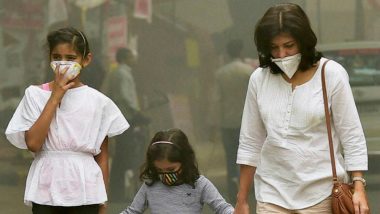New Delhi, November 23: The air quality in the national capital slipped to 'very poor' category on Saturday morning, and is likely to get worse in the coming weeks. Pollutants called PM10, which are fine enough to cause respiratory diseases was recorded at 372, according to System of Air Quality and Weather Forecasting And Research (SAFAR). The Particulate Matter 2.5, which are finer and are capable of entering the bloodstream, through the lungs, docked at 183 at 8: 15 am in the morning. Delhi: AIIMS Launches Research Project on Air Pollution’s Impact on Public Health.
"Air quality index is in the 'very poor' category and expected to increase further by tomorrow but will remain in very poor. Thereafter a slight improvement is predicted. At present, wind speed is slow and hence not good for air quality as it allows pollution to get accumulated. Humidity continued to be high and the temperature is likely to cool, both unfavourable. Stubble fire will have a marginal impact," the SAFAR added.
At Dhirpur, the AQI was 335 at 8:15 am, while in Mathura Road area it dipped very poor at 363. Furthermore, AQI near Pitampura, Airport Terminal 3 and Delhi University stood at 379, 335 and 357 respectively. Delhi Air Pollution: Emergency Plan Rolled Out; Here’s All You Need to Know About the Plan and How It May Affect You.
The India Meteorological Department has predicted that the temperatures in Delhi will remain stable as yesterday, with highs and lows reaching 31 Degree Celsius and 13 Degrees Celsius along with haze and mist in the air.
Speaking to ANI, Anand Sharma, a resident of Delhi said that air problem is not causing them breathing issue but also is harming their digestive system. He also said that a solid step should be taken to prevent the air from getting intoxicated further. " This is not the first time that this poor atmosphere has prevailed in Delhi. I am been witnessing this from the past 5 years. Something solid should be done now," he added.
The menace of air pollution is not restricted to Delhi or the National Capital Region, but, is also engulfing most parts of the country especially metropolitan cities. According to the data compiled by Central Pollution Control Board in October, out of 68 cities, only 13 had AQI levels lower than 100, while 10 recorded AQI levels above 300.
During winter season each year, most of the northern part of India suffers from a spike in toxicity in the air due to the change in weather patterns and crop residue burning in neighbouring states such as Haryana, Punjab and Uttar Pradesh. Not only that, but a dip in temperature along with low wind speed also tends to trap the air pollutants closer to the ground. (ANI)
(The above story is verified and authored by ANI staff, ANI is South Asia's leading multimedia news agency with over 100 bureaus in India, South Asia and across the globe. ANI brings the latest news on Politics and Current Affairs in India & around the World, Sports, Health, Fitness, Entertainment, & News. The views appearing in the above post do not reflect the opinions of LatestLY)













 Quickly
Quickly


